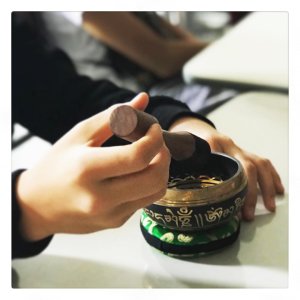Mindfulness in High School
A teacher shares how she implements daily mindful moments and their positive impact on classroom culture.
Some classrooms have a certain aura, don’t they? When you enter, there’s a sense of peace, community, clarity, and active presence from all stakeholders. That is the kind of classroom I want to create, and one way I’ve sought to accomplish this is by taking a course in mindfulness for educators. Since then, I have led daily mindful moments in all of my classes. It’s been transformative for classroom culture.
Here are some responses I’ve gotten since I introduced this practice:
- One day students in my International Baccalaureate class arrived with a heavy sense of deep fatigue radiating from them. After checking in, I led a mindful moment in which we focused on gratitude, and then we shared one compliment about the person beside us. The students’ attitude became noticeably more positive.
- One of my sophomores approached me to remind me of the upcoming anniversary of a relative’s death. He asked if he could come to class early for a mindful moment. He and I sat for a moment of breathing and mindful honoring of his relative. As his classmates rolled in, they did so quietly, respecting his space.
- I hear phrases like these from students: “Guess what? I practiced mindfulness before my soccer game” and “Mindfulness helped me with my presentation” and “I used mindfulness before I went to sleep last night.”
Mindfulness in My High School Classroom
How have we achieved this?
First and foremost, I focus every day on my own practice of mindfulness through regular use of an app, attendance at retreats, and reading research. As teachers, we know our students can spot a fake within three seconds flat. If the mindfulness practice in the classroom feels fake, meaningful engagement decreases.
I introduced mindfulness at the beginning of this school year, giving a heads-up to both students and parents that we’d be practicing daily mindful moments, why we’d do that, and what they would look like.
Each period after greeting students, I remind them of the ways we’ve practiced mindfulness: mindful listening, diaphragmatic breathing, gratitude journals, progressive muscle relaxation, affirmations, etc.
To begin the practice, I guide students into a space of mindfulness—computers at half-mast, phones away, lights dimmed, no speaking. Then I cue the posture: Often we are seated with a tall spine, neck bent slightly, feet firmly planted on the floor, eyes gently closed. Sometimes we lie on the floor with our legs up the wall, and sometimes students can choose their position. I cue attention to the current experience. Most often we pay attention to our breathing, but sometimes we focus on ambient sounds, our emotions, a mental activity, etc.
Some days, that’s it—I close the practice verbally or with a student’s chime of the singing bowl. Other days, I introduce a specific kind of mindfulness focus. All of this can last anywhere from one to 10 minutes.

Often, class mindfulness programs begin with small lessons where teachers explain the practice and then spend a few moments in mindfulness. I’ve found learning through practice to be the most beneficial, as well as the most time effective. Just doing a mindful activity generates questions from students, allowing their experience to be more authentic and relevant.
Since this is the first year in which I’ve led daily mindful moments in my classes, at the end of the first semester I solicited student feedback. It is clear students appreciate the practice—most students want to continue our mindful practice and feel that they benefit from it. (Here are the full results of the survey. Prompts, averages, individual responses, and student comments are included.)
Despite such positive results, there are challenges.
Some students just don’t get into it, resulting in whispers, giggling, and other forms of disengagement. I address this both publicly and privately. While the distractions are occurring, I might say, “Notice, without judgment, the sounds in the classroom: giggling, texting, etc. They are part of our experience.” This minimizes the power of distractions. And I will later pull disruptive students in for a private chat. Typically that goes something like: “You don’t have to like mindfulness; in fact, you don’t even have to participate. But under no circumstances can you distract your peers who might be benefiting from it.”
Some days are better than others. I accept this, without judgment, as part of the experience. Rather than using mindfulness as a technique to control student behavior—which can never be the aim—I neutrally observe the actual experience. As in all areas of instruction, I come back to the importance of my own practice: It is my authentic investment that encourages students to invest.
In the end, it’s worth it. Students report that mindfulness helps with stress, confidence, relationships, communication, metacognition, health, and focus.
And it creates the kind of classroom where we all want to be.
